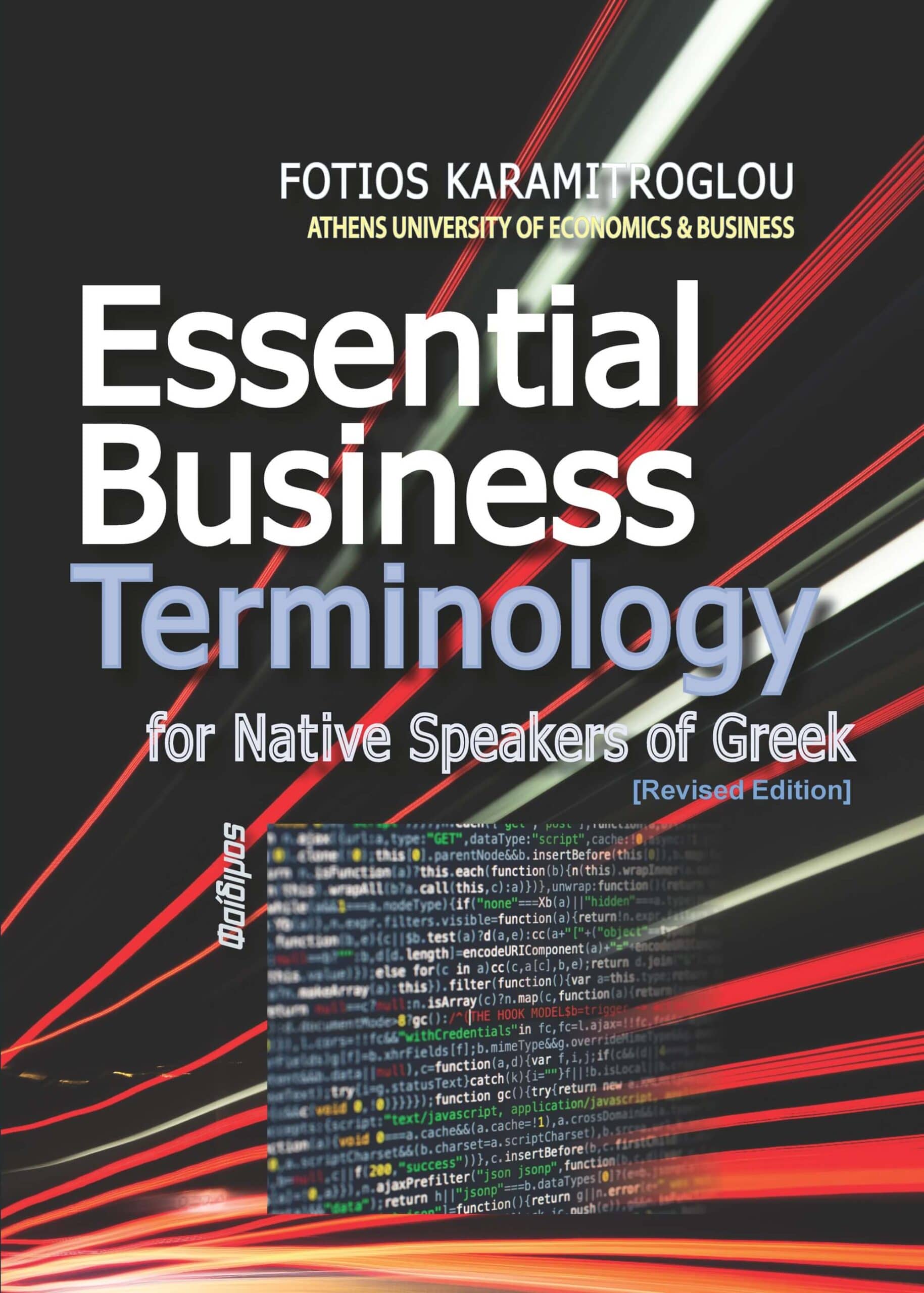Περιγραφή
- Overview
This book has been designed to serve the needs of various terminology-based modules run by the Athens University of Economics and Business (AUEB). It is a coursebook, in essence, that epitomises the keynotes and material delivered in class to students of Business Administration, Marketing & Communication, Accounting & Finance, Economics, and International and European Economic Studies. It is the offspring of careful observation, in-depth analysis and extensive feedback on the needs of students attending the English Language modules at AUEB, as well as consultation with fellow teachers at other tertiary education institutions where Business English is generally taught. - Key Figures
The book comprises 6 Chapters and 29 Units, overall. The Units contain an aggregate of around 1360 primary terms, 870 semantic fields that explode into almost 3780 primary and secondary terms, and approximately 820 collocations. This equals to an average of 47 primary terms, 30 semantic fields that contain 130 primary and secondary terms, and approximately 28 collocations per Unit. 14 Units begin with a text in English, whereas 15 start with a Greek text as reference. On average, each reference text is about 540 words long and a Unit can be fully covered within 3 hours of teaching. This means that 87 hours of teaching is the expected benchmark, if a teacher is to exhaust each and every Unit. Conversely, given that an academic semester normally comprises 52 teaching hours (13 weeks x 4 hours), a teacher may cover up to 17 Units, selecting those which fit best the needs of his/her classroom. To this end, a number of primary and secondary terms reappear across the Units. - Structure
Each Unit spins around 4 types of exercises that take students on a journey from the level of the individual term, to that of term-containing passage. Each exercise develops a different skill: Exercise A helps students initially build and gradually expand their primary vocabulary; Exercise B trains students to distinguish between seemingly related yet diverse terms from overlapping or neighbouring semantic fields; Exercise C assigns the task of forming appropriate collocations by dressing terms with suitable lexical items; and Exercise D asks students to translate the reference text into the other language, thereby elaborating into complete sentences and paragraphs that are rich in business terminology. The form of Exercise A depends on the language of the text which is used as reference, whereas exercises B, C and D are invariable.
More specifically, in Exercise A (“Vocabulary Building”), if the language of the reference text is English, students are asked in a find-the-word-in-the-text mode to skim the English text in order to match a list of selected Greek terms with their English counterparts. Conversely, if the reference text is Greek, selected Greek terms from the text are assigned with three multiple choice options of potential English equivalents, and students are asked to identify the correct option. In this latter case, more than one options may be correct, but never all three.
Exercise B (“Clarifying Terminology and Expanding Vocabulary”) is an extension of Exercise A. Greek terms which appear as primary vocabulary in Exercise A are used as pivot or starting points, wherefrom secondary terms that belong to affiliated semantic fields but have narrower, broader or other seemingly related usage are further investigated.
Exercise C (“Useful Collocations”) aims to put the terms in context. A verb, adjective, adverb or noun is sought to accompany a term so as to build a fluent collocation.
Finally, Exercise D (“From Term to Text”) summons all skills developed in the three previous exercises by calling for the whole text to be translated into the other language (English from/into Greek). Students transcend from the termand- phrase to the sentence-and-paragraph level by putting in place other non-terminological items and carefully tending to grammar and syntax. - Suggested Use
The book has been designed to serve a variety of Business English audiences and cover a range of terminological aspects:
If the audience is Business Administration oriented, the teacher is advised to focus on Chapter 3, and parts of Chapters 1, 2, 4 and 5.
If the audience is Marketing & Communication oriented, the teacher is advised to focus on Chapters 5 and 3, and parts of Chapters 1, 4 and 6.
If the audience is Accounting & Finance oriented, the teacher is advised to focus on Chapters 2 and 1, and parts of Chapters 4 and 6.
Finally, if the audience is oriented towards European Economic Studies, the teacher is advised to focus on Chapters 6, 1 and 2, and parts of Chapters 3 and 4.
The current Revised Edition comes with Sample Translations for all reference texts. These Sample Translations may be used by students to solve Exercises A and C, since the terms that are sought in these two exercises appear in the Sample Translation of each corresponding Unit; hence, they may be correctly spotted if the reference text and its sample translation are approached in a manner of parallel contrastive study. Moreover, the Sample Translations may serve as discussion point to teachers, asking students to rewrite or modify them, hence viewing Exercise D from a more creative angle. - Disclaimer
This is to state explicitly that the extracts used in the present coursebook may not correspond to their original sources, since their content has been severely manipulated, adjusted and/or condensed to serve the specific terminological needs of each and every Unit. Original sources have been merely used as points of influence or inspiration, to create texts that combine richness of vocabulary and authenticity of content and style.




